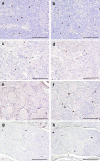Expression of the cellular prion protein by mast cells in white-tailed deer carotid body, cervical lymph nodes and ganglia
- PMID: 39285618
- PMCID: PMC11409499
- DOI: 10.1080/19336896.2024.2402225
Expression of the cellular prion protein by mast cells in white-tailed deer carotid body, cervical lymph nodes and ganglia
Abstract
Chronic wasting disease (CWD) is a transmissible and fatal prion disease that affects cervids. While both oral and nasal routes of exposure to prions cause disease, the spatial and temporal details of how prions enter the central nervous system (CNS) are unknown. Carotid bodies (CBs) are structures that are exposed to blood-borne prions and are densely innervated by nerves that are directly connected to brainstem nuclei, known to be early sites of prion neuroinvasion. All CBs examined contained mast cells expressing the prion protein which is consistent with these cells playing a role in neuroinvasion following prionemia.
Keywords: Carotid body; chronic wasting disease; lymph node; mast cell; nodose ganglion; prions; superior cervical ganglion; white-tailed deer.
Conflict of interest statement
No potential conflict of interest was reported by the author(s).
Figures





References
-
- Chronic wasting disease: occurrence. Centers for Disease Control and Prevention. [cited 2023 Dec 20]. Available from: https://www.cdc.gov/prions/cwd/occurrence.html
Publication types
MeSH terms
Substances
Grants and funding
LinkOut - more resources
Full Text Sources
Other Literature Sources
